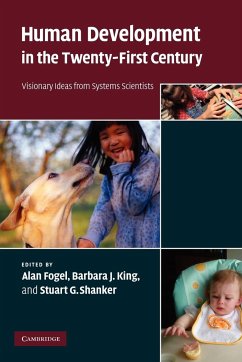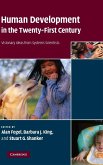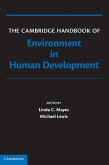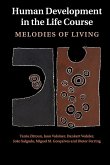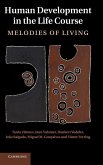Human Development in the Twenty-First Century
Visionary Ideas from Systems Scientists
Herausgeber: Fogel, Alan; Shanker, Stuart G.; King, Barbara J.
Human Development in the Twenty-First Century
Visionary Ideas from Systems Scientists
Herausgeber: Fogel, Alan; Shanker, Stuart G.; King, Barbara J.
- Broschiertes Buch
- Merkliste
- Auf die Merkliste
- Bewerten Bewerten
- Teilen
- Produkt teilen
- Produkterinnerung
- Produkterinnerung
A dynamic group of systems scientists consider ways to enhance human development worldwide.
Andere Kunden interessierten sich auch für
![Human Development in the Twenty-First Century Human Development in the Twenty-First Century]() Alan Fogel / Barbara J. King / Stuart G. Shanker (eds.)Human Development in the Twenty-First Century118,99 €
Alan Fogel / Barbara J. King / Stuart G. Shanker (eds.)Human Development in the Twenty-First Century118,99 €![Preparing Adolescents for the Twenty-First Century Preparing Adolescents for the Twenty-First Century]() Preparing Adolescents for the Twenty-First Century87,99 €
Preparing Adolescents for the Twenty-First Century87,99 €![Subjectivity in the Twenty-First Century Subjectivity in the Twenty-First Century]() Subjectivity in the Twenty-First Century42,99 €
Subjectivity in the Twenty-First Century42,99 €![Taking Psychology and Law Into the Twenty-First Century Taking Psychology and Law Into the Twenty-First Century]() James R. P. OgloffTaking Psychology and Law Into the Twenty-First Century191,99 €
James R. P. OgloffTaking Psychology and Law Into the Twenty-First Century191,99 €![The Cambridge Handbook of Environment in Human Development The Cambridge Handbook of Environment in Human Development]() The Cambridge Handbook of Environment in Human Development136,99 €
The Cambridge Handbook of Environment in Human Development136,99 €![Human Development in the Life Course Human Development in the Life Course]() Jaan ValsinerHuman Development in the Life Course47,99 €
Jaan ValsinerHuman Development in the Life Course47,99 €![Human Development in the Life Course Human Development in the Life Course]() Jaan ValsinerHuman Development in the Life Course133,99 €
Jaan ValsinerHuman Development in the Life Course133,99 €-
-
-
A dynamic group of systems scientists consider ways to enhance human development worldwide.
Hinweis: Dieser Artikel kann nur an eine deutsche Lieferadresse ausgeliefert werden.
Hinweis: Dieser Artikel kann nur an eine deutsche Lieferadresse ausgeliefert werden.
Produktdetails
- Produktdetails
- Verlag: Cambridge University Press
- Seitenzahl: 270
- Erscheinungstermin: 7. September 2011
- Englisch
- Abmessung: 229mm x 152mm x 15mm
- Gewicht: 396g
- ISBN-13: 9781107403147
- ISBN-10: 1107403146
- Artikelnr.: 33623922
- Herstellerkennzeichnung
- Libri GmbH
- Europaallee 1
- 36244 Bad Hersfeld
- gpsr@libri.de
- Verlag: Cambridge University Press
- Seitenzahl: 270
- Erscheinungstermin: 7. September 2011
- Englisch
- Abmessung: 229mm x 152mm x 15mm
- Gewicht: 396g
- ISBN-13: 9781107403147
- ISBN-10: 1107403146
- Artikelnr.: 33623922
- Herstellerkennzeichnung
- Libri GmbH
- Europaallee 1
- 36244 Bad Hersfeld
- gpsr@libri.de
Preface: the dynamic systems approach to fostering human development Alan
Fogel, Barbara J. King and Stuart G. Shanker; Part I. Dynamic Relationships
between Genetics and Environments: 1. Developmental dynamics: the new view
from the life sciences Robert Lickliter; 2. Genes, experience and behaviour
Timothy D. Johnston; 3. How dynamic systems have changed our minds Ken
Richardson; 4. Individual development as a system of coactions:
implications for research and policy Gilbert Gottlieb and Carolyn Tucker
Halpern; 5. Gene-environment interactions and inter-individual differences
in rhesus monkey behavioral and biological development Stephen J. Suomi;
Part II. The Dynamic System of the Child in the Family: 6. Relationships
that support human development Alan Fogel; 7. The impact of emotions and
the emotional impact of a child's first words Stuart G. Shanker; 8.
Emotional habits in brain and behaviour: a window on personality
development Marc D. Lewis; 9. Creating family love: an evolutionary
perspective Barbara J. King; Part III. The Dynamic System of the Child in
Social and Physical Environment: 10. The tempest: anthropology and human
development Peter Gow; 11. An anthropology of human development: what
difference does it make? Christina Toren; 12. The social child Tim Ingold;
13. Learning about human development from a study of educational failure
Gillian Evans; 14. Dynamic views of education Lynette Friedrich Cofer; 15.
Embodied communication in non-human animals Barbara Smuts; 16. Children in
the living world: why animals matter for children's development Gail F.
Melson; Part IV. Dynamic Systems Approaches to Mental Health: 17. A dynamic
developmental model of mental health and mental illness Stanley I.
Greenspan; 18. Dyadic microanalysis of mother-infant communication informs
clinical practice Beatrice Beebe and Joseph Jaffe; 19. Current problems of
Japanese youth: some possible pathways for alleviating these problems from
the perspective of dynamic systems theory Alan Fogel and Masatoshi Kawai;
20. A different way to help George Downing; 21. Why do siblings often turn
out very differently? Michael E. Kerr; 22. A dynamic systems approach to
understanding family and peer relationships: implications for effective
interventions with aggressive youth Isabela Granic; 23. Prenatal substance
exposure and human development Daniel S. Messinger and Barry M. Lester;
Part V. Conclusions and Outlook: 24. Dynamic systems methods for the life
sciences Alan Fogel, Stanley Greenspan, Barbara J. King, Robert Lickliter,
Pedro Reygadas, Stuart G. Shanker and Christina Toren.
Fogel, Barbara J. King and Stuart G. Shanker; Part I. Dynamic Relationships
between Genetics and Environments: 1. Developmental dynamics: the new view
from the life sciences Robert Lickliter; 2. Genes, experience and behaviour
Timothy D. Johnston; 3. How dynamic systems have changed our minds Ken
Richardson; 4. Individual development as a system of coactions:
implications for research and policy Gilbert Gottlieb and Carolyn Tucker
Halpern; 5. Gene-environment interactions and inter-individual differences
in rhesus monkey behavioral and biological development Stephen J. Suomi;
Part II. The Dynamic System of the Child in the Family: 6. Relationships
that support human development Alan Fogel; 7. The impact of emotions and
the emotional impact of a child's first words Stuart G. Shanker; 8.
Emotional habits in brain and behaviour: a window on personality
development Marc D. Lewis; 9. Creating family love: an evolutionary
perspective Barbara J. King; Part III. The Dynamic System of the Child in
Social and Physical Environment: 10. The tempest: anthropology and human
development Peter Gow; 11. An anthropology of human development: what
difference does it make? Christina Toren; 12. The social child Tim Ingold;
13. Learning about human development from a study of educational failure
Gillian Evans; 14. Dynamic views of education Lynette Friedrich Cofer; 15.
Embodied communication in non-human animals Barbara Smuts; 16. Children in
the living world: why animals matter for children's development Gail F.
Melson; Part IV. Dynamic Systems Approaches to Mental Health: 17. A dynamic
developmental model of mental health and mental illness Stanley I.
Greenspan; 18. Dyadic microanalysis of mother-infant communication informs
clinical practice Beatrice Beebe and Joseph Jaffe; 19. Current problems of
Japanese youth: some possible pathways for alleviating these problems from
the perspective of dynamic systems theory Alan Fogel and Masatoshi Kawai;
20. A different way to help George Downing; 21. Why do siblings often turn
out very differently? Michael E. Kerr; 22. A dynamic systems approach to
understanding family and peer relationships: implications for effective
interventions with aggressive youth Isabela Granic; 23. Prenatal substance
exposure and human development Daniel S. Messinger and Barry M. Lester;
Part V. Conclusions and Outlook: 24. Dynamic systems methods for the life
sciences Alan Fogel, Stanley Greenspan, Barbara J. King, Robert Lickliter,
Pedro Reygadas, Stuart G. Shanker and Christina Toren.
Preface: the dynamic systems approach to fostering human development Alan
Fogel, Barbara J. King and Stuart G. Shanker; Part I. Dynamic Relationships
between Genetics and Environments: 1. Developmental dynamics: the new view
from the life sciences Robert Lickliter; 2. Genes, experience and behaviour
Timothy D. Johnston; 3. How dynamic systems have changed our minds Ken
Richardson; 4. Individual development as a system of coactions:
implications for research and policy Gilbert Gottlieb and Carolyn Tucker
Halpern; 5. Gene-environment interactions and inter-individual differences
in rhesus monkey behavioral and biological development Stephen J. Suomi;
Part II. The Dynamic System of the Child in the Family: 6. Relationships
that support human development Alan Fogel; 7. The impact of emotions and
the emotional impact of a child's first words Stuart G. Shanker; 8.
Emotional habits in brain and behaviour: a window on personality
development Marc D. Lewis; 9. Creating family love: an evolutionary
perspective Barbara J. King; Part III. The Dynamic System of the Child in
Social and Physical Environment: 10. The tempest: anthropology and human
development Peter Gow; 11. An anthropology of human development: what
difference does it make? Christina Toren; 12. The social child Tim Ingold;
13. Learning about human development from a study of educational failure
Gillian Evans; 14. Dynamic views of education Lynette Friedrich Cofer; 15.
Embodied communication in non-human animals Barbara Smuts; 16. Children in
the living world: why animals matter for children's development Gail F.
Melson; Part IV. Dynamic Systems Approaches to Mental Health: 17. A dynamic
developmental model of mental health and mental illness Stanley I.
Greenspan; 18. Dyadic microanalysis of mother-infant communication informs
clinical practice Beatrice Beebe and Joseph Jaffe; 19. Current problems of
Japanese youth: some possible pathways for alleviating these problems from
the perspective of dynamic systems theory Alan Fogel and Masatoshi Kawai;
20. A different way to help George Downing; 21. Why do siblings often turn
out very differently? Michael E. Kerr; 22. A dynamic systems approach to
understanding family and peer relationships: implications for effective
interventions with aggressive youth Isabela Granic; 23. Prenatal substance
exposure and human development Daniel S. Messinger and Barry M. Lester;
Part V. Conclusions and Outlook: 24. Dynamic systems methods for the life
sciences Alan Fogel, Stanley Greenspan, Barbara J. King, Robert Lickliter,
Pedro Reygadas, Stuart G. Shanker and Christina Toren.
Fogel, Barbara J. King and Stuart G. Shanker; Part I. Dynamic Relationships
between Genetics and Environments: 1. Developmental dynamics: the new view
from the life sciences Robert Lickliter; 2. Genes, experience and behaviour
Timothy D. Johnston; 3. How dynamic systems have changed our minds Ken
Richardson; 4. Individual development as a system of coactions:
implications for research and policy Gilbert Gottlieb and Carolyn Tucker
Halpern; 5. Gene-environment interactions and inter-individual differences
in rhesus monkey behavioral and biological development Stephen J. Suomi;
Part II. The Dynamic System of the Child in the Family: 6. Relationships
that support human development Alan Fogel; 7. The impact of emotions and
the emotional impact of a child's first words Stuart G. Shanker; 8.
Emotional habits in brain and behaviour: a window on personality
development Marc D. Lewis; 9. Creating family love: an evolutionary
perspective Barbara J. King; Part III. The Dynamic System of the Child in
Social and Physical Environment: 10. The tempest: anthropology and human
development Peter Gow; 11. An anthropology of human development: what
difference does it make? Christina Toren; 12. The social child Tim Ingold;
13. Learning about human development from a study of educational failure
Gillian Evans; 14. Dynamic views of education Lynette Friedrich Cofer; 15.
Embodied communication in non-human animals Barbara Smuts; 16. Children in
the living world: why animals matter for children's development Gail F.
Melson; Part IV. Dynamic Systems Approaches to Mental Health: 17. A dynamic
developmental model of mental health and mental illness Stanley I.
Greenspan; 18. Dyadic microanalysis of mother-infant communication informs
clinical practice Beatrice Beebe and Joseph Jaffe; 19. Current problems of
Japanese youth: some possible pathways for alleviating these problems from
the perspective of dynamic systems theory Alan Fogel and Masatoshi Kawai;
20. A different way to help George Downing; 21. Why do siblings often turn
out very differently? Michael E. Kerr; 22. A dynamic systems approach to
understanding family and peer relationships: implications for effective
interventions with aggressive youth Isabela Granic; 23. Prenatal substance
exposure and human development Daniel S. Messinger and Barry M. Lester;
Part V. Conclusions and Outlook: 24. Dynamic systems methods for the life
sciences Alan Fogel, Stanley Greenspan, Barbara J. King, Robert Lickliter,
Pedro Reygadas, Stuart G. Shanker and Christina Toren.

